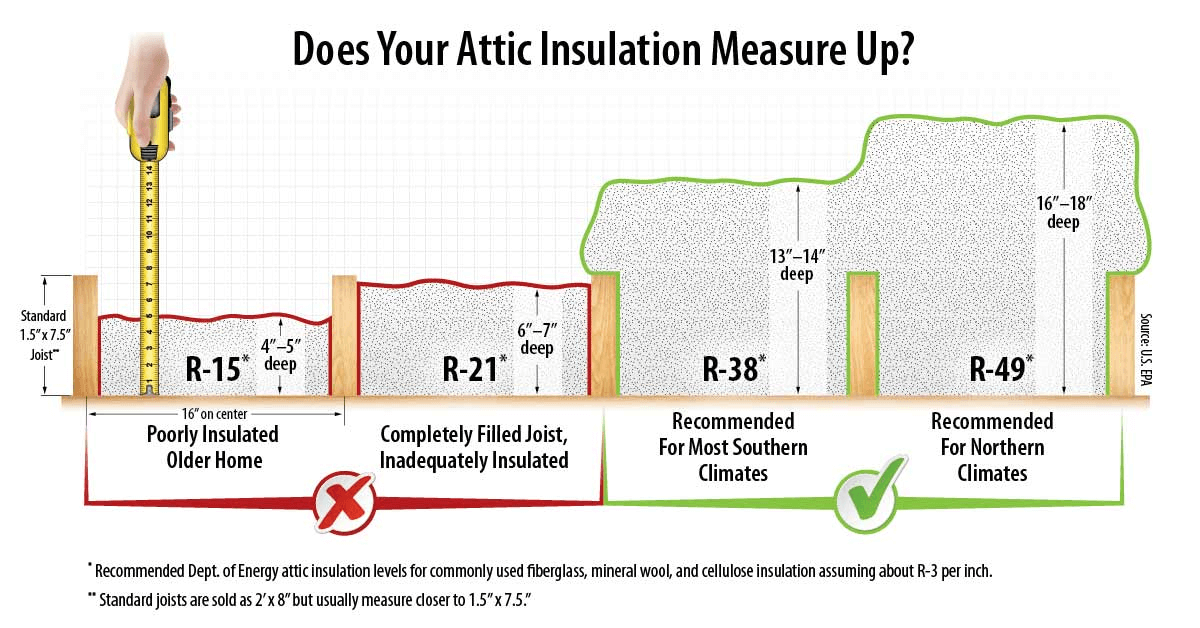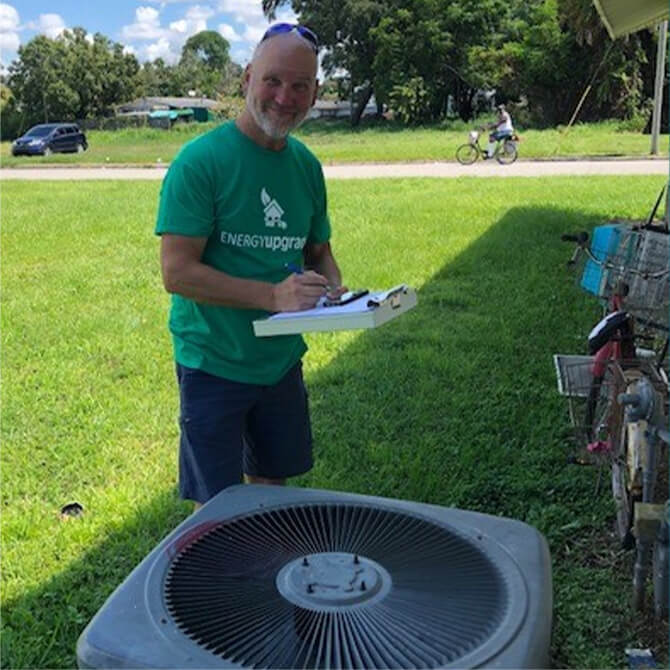Tame The Energy Hogs
There are many free and low-cost ways to save energy and lower your electric bill, while increasing home comfort and helping to slow global warming. Tackle the top power hogs first for maximum results. In Florida homes, air conditioners gobble the most power—about 40-50% of energy use in most homes. Always-on electronic devices, hot water heaters, and pool pumps each use about 12-15% of the total.

We’ve sifted through all sorts of energy saving tips to find the ones that are easiest and most effective. In many cases, the solutions are free—you just make a small tweak to the way you do things. There are also many low-cost solutions that only require a quick trip to the home improvement store.
Cost: $0-250
Cost: Free
Using a ceiling fan can help save energy, but only if you also raise the thermostat by at least 2 degrees (or at least avoid turning it down).
Cost: $0-150
Cost: $0-1,000+
Sealing and insulating your home is one of the most cost-effective ways to make your home more comfortable and energy efficient, with savings of 20% or more on heating and cooling costs. Bonus benefits include reduced outside noise, pollen, dust, and insects entering your home, and better humidity control. Warm and cool air can escape through leaks in outer walls, floors, ceilings, doors, and windows. Energy losses from all the leaks, holes, and gaps are like having a window open every day of the year!

Watch: How To Measure Attic Insulation
Use this sealing and insulation project guide to help decide which projects you want to tackle on your own, and which you should leave to a professional.
You may be eligible for a rebate of up to $190 from FPL and a Federal tax credit of up to $500. Professional Installation $1500+

Guide to planting Florida shade trees for energy savings.
Learn more about how to select, plant, and care for trees.
Cost: $5-25
The devices and gadgets of modern life waste huge amounts of energy when idle—an estimated 50 power plants worth of energy nationally every year! Electronic devices such as computers, televisions, and stereos and gaming systems consume electricity even when they are turned off, sucking up and wasting 12 percent of a home’s annual electricity use. That’s why adapters plugged into the wall feel slightly warm even when not in use.
Cost: $0-1,500+
Water heaters are typically among the top three energy hogs in the home. The average family spends about $15–20 per month to heat water. To trim those costs, heat more efficiently and use less hot water.
When to replace your water heater
Wondering if you should consider a solar water heater?
Cost: $0-20

Cost: Free
We Floridians love our swimming pools. But running a pool pump 8 hours a day can add $40–60 per month to your electric bill. Careful maintenance of your pool’s water clarity and chemical level can reduce the amount of time the pump needs to run and save $4–5 per month for every hour you cut back.
Cost: $1.50-30
Lighting isn’t typically a big energy waster in most homes, but light-emitting diode (LED) bulbs are a smart choice for lights you use several hours a day. LED bulbs last 10 times longer than traditional incandescent bulbs, so they’ll rarely need replacement, and they are 75% more energy-efficient too. DIY $1.50
Shopping for new LED bulbs presents an overwhelming number of choices. Let’s break it down:
Watch: How To Choose Lightbulbs
Automatic switches can enhance lighting efficiency and safety:
Now that you know your options, see how much you can save by taking these energy saving actions around your home.
Input Your Actions
Savings – kWh/mo
$/mo
tons GHG/yr
Turn up the thermostat to 78°F
Install a smart Thermostat
Install attic insulation
Turn off fans
Lower water heater temp 10 degrees F
Do laundry in cold water (wkly)
Hang dry laundry (wkly)
Use smart plugs for electronics
Reduce pool pump run time
Install LED lightbulbs
Unplug unused freezer
One year of the energy conservation actions above would prevent (X) tons of GHG emissions, the equivalent of:
0 acres of forests growing for one year
0 tree seedlings grown for 10 years
0 miles driven in a gas-powered car (22.5mpg)
How are these calculated?
Greenhouse Gases Equivalencies Calculator (EPA.gov)
Estimating Appliance and Home Electronic Energy Use (Energy.gov)
This free online class will teach you cost-saving energy and water conservation strategies. Participants receive a free Do-It-Yourself Energy Saving Kit (one per household) with ENERGY STAR LED light bulbs, WaterSense faucet aerators, a smart power strip, weatherizing materials, outlet insulating gaskets, and other useful goodies. You’ll also learn low and no-cost tips that, combined with the kits, can reduce your household energy costs as much as $560 per year. Take the pre-recorded class at your own pace. Or register for a live class.
Sarasota County “Energy Coach” Volunteers share their knowledge and passion for smart energy use by providing consultations with community members, performing assessments and installations, and participating in community events. The training for Energy Coaches includes low- and no-cost energy upgrade options, local energy equity, and hands-on experience with industry professionals. To learn more and inquire about training dates, contact SustainableSarasota@scgov.net or 941-861-9829.

Find out what’s happening and join in with our comprehensive community events listing.
Local, state, federal, and utility rebates and incentives may be available to help pay for some home energy improvements.
Both the ENERGY STAR and the EnergyGuide labels are intended to help you make smart energy choices when shopping for new appliances and electronics. The blue ENERGY STAR label will help you easily identify which products meet strict guidelines for saving energy set by the EPA. The yellow and black EnergyGuide can be used to directly compare your top choices and give you an estimate of the energy use and operating cost.
Although you will use some energy to reheat water after your heater has been turned off, it will still be less energy overall compared to having your heater on all hours of everyday. Modern water heater tanks are insulated, so all you really need is to turn it on an hour or two before you plan to use the shower. Dishwashers don’t rely on hot water from your tank, they heat the water themselves.
There are several ways to save energy while you’re away:
LED bulbs are 75 – 80% more efficient than incandescent bulbs, which means in order to save the same amount of money by turning off incandescent bulbs, you would need to have your lights off 75 – 80% longer than you would if you had LEDs. For example, having an LED light bulb on for 4 hours uses the same amount of energy as a traditional incandescent bulb does in just 1 hour.
Here are 10 steps you can take to improve the sustainability of your business:
By setting specific goals and implementing targeted initiatives, you can make meaningful strides towards sustainability while working towards becoming a Sarasota County Green Business Partner.
Submit your energy-related question to local sustainability experts. If selected, they will answer and feature your question on our FAQ. Not all questions will be answered.
Mind if we stay in touch?
We'll send you our free Toolkit Quick Reference Guide.
We'll never spam you or share your info. Unsubscribe at any time.
This site protected by reCAPTCHA and the Google Privacy Policy and Term of Service apply.
©2025 Science and Environment Council of Southwest Florida | Site by Chariot.